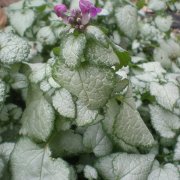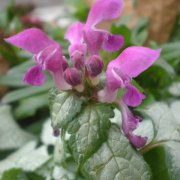Care of the plant Lamium maculatum or Purple dragon |
|
The genus Lamium, family Lamiaceae, comprises 50 species of herbaceous plants native to the Middle East, Europe and North Africa. Some species are: Lamium maculatum, Lamium album, Lamium galeobdolon (Lamiastrum galeobdolon), Lamium purpureum, Lamium flexuosum. Common names: Purple dragon, Spotted dead-nettle, Spotted henbit. This species is native to Europe and Asia. They are small herbaceous plants with a creeping bearing that reach 20 cm (7.87") in height. The leaves are oval or triangular in shape and can be green with white spots or silver-green. The tubular flowers appear in terminal inflorescences and can be purple, pink or white. They bloom during the second half of summer. Purple dragon is used as undergrowth coverings under shrubs or trees. If it's grown in pots it will need regular watering. Lamium maculatum grow in semi-shady, shaded or full sun exposures (if the summer is not very hot). It resists frosts but can lose leaves and sprout again in spring. Spotted henbit can grow in well-drained limestone or acid soils that contain a lot of organic matter. Planting can be done at any time at a distance of 40 cm (15.74") between plants. Water regularly (without overwatering) so that the substrate never dries out completely; wait for the substrate surface to dry. Fertilize in late winter with compost and with mineral fertilizer in mid-spring. Prune faded flowers and control horizontal growth because it can become an invasive plant. Lamium maculatum is a plant resistant to pests and diseases but are sensitive to drought. Purple dragon propagates by division at any time of the year. |
Images of the plant Lamium maculatum or Purple dragon |
Find plants
Lamium maculatum or Purple dragon | Care and Growing
© 2025 FavThemes


